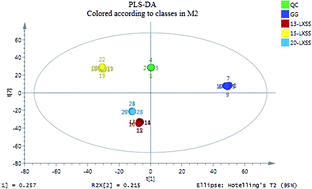Metabolomics analysis based on a UPLC-Q-TOF-MS metabolomics approach to compare Lin-Xia-Shan-Shen and garden ginseng†
Abstract
Background: Panax ginseng Meyer which has been cultivated and grown naturally in mountainous forests is formally called “Lin-Xia-Shan-Shen” (LXSS), but when cultivated it is called garden ginseng (GG), according to the Chinese Pharmacopoeia (2015 edition). The medicinal value of LXSS is significantly higher than that of GG based on the clinical experience of TCM. This study aimed to evaluate the variety of chemical constituents in LXSS and GG. Methods: 18 LXSS and 6 GG samples were investigated using a UPLC-Q-TOF-MS technique. Results: the contents of 16 metabolites, mainly involved in the biosynthesis of rare ginsenosides (ginsenosides Rg3, -Rh1, -Rh2), galactose metabolism (myo-inositol), the citric cycle (citric acid and succinic acid), GABA shunt (GABA) and amino metabolism (alanine and aspartic acid), were higher in LXSS than in GG; while 14 metabolites, mainly involved in starch and sucrose metabolism (fructose and sucrose), amino metabolism (tryptophan, proline, dencichine and pyroglutamic acid) and campesterol biosynthesis (campesterol), were lower in LXSS than in GG. For LXSS with different growing years, 5 metabolites showed a tendency to increase dependent on the number of years, and these were related mainly to galactose metabolism (melibiose), the citric cycle (malic acid), fatty acid metabolism (2-hydroxy stearic acid); while 5 metabolites showed a tendency to decrease on ascending the grades, and these were related to sucrose metabolism (fructose and sucrose), fatty acid metabolism (2-hydroxy hexadecanoic acid) and campesterol biosynthesis (campesterol). Conclusion: this proposed analytical method coupled with multivariate analysis is fast, accurate, and reliable for discriminating GG and high cultivation ages of LXSS samples.



 Please wait while we load your content...
Please wait while we load your content...